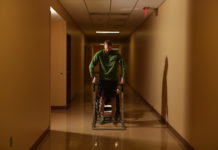Once children are old enough to be out of a car seat, a booster seat raises them to a height where adult seat belts will fit correctly. If a child is not in the correct position, the lap belt can ride up over the stomach and the shoulder belt can lay across the neck, risking serious abdominal or neck injury if the vehicle comes to an abrupt stop.
Any child under 40 inches tall must be in a child or infant seat. Previously, Kentucky law required that children be strapped into a booster seat if they are younger than 7 years old and between 40 and 50 inches in height. The new law raises the requirements to younger than 8 years old and between 40 and 57 inches tall. This is in accordance with guidelines set by the American Academy of Pediatrics and in line with several other states.
All children over the age of 8 or over 57 inches tall must wear a seat belt.
“While parents are concerned about all kinds of things when it comes to their children’s safety, what is most likely to seriously injure a child in the U.S. is riding in a car, which we do every single day,” said Dr. Heather Felton, a pediatrician with University of Louisville Physicians. “We have to make it as safe as possible, because that’s where they are in the most danger.”
According to Partners for Child Passenger Safety, more than 90 percent of 4- to 8-year-old children who were seriously injured in a crash were not in a booster seat.
Choosing the right seat
Proper use of car and booster seats can be confusing for many parents.
Dr. Felton said very young children should ride in a rear-facing car seat, and the child should stay in that type of seat as long as the model allows (using the manufacturer’s height and weight requirements as a guide). She said that is the safest way to ride.
“A lot of parents get in a rush and turn the child around too early,” she said. “They should be in a rear-facing car seat up to 3 or 4 years of age – and that’s a lot longer than most people think.”
The child can then be placed in a forward-facing car seat and stay there until they meet the maximum height and weight requirements for that model, Dr. Felton said.
At that point, children should graduate to a booster seat. For proper fit, the lap belt should fit low on the hips or high on the thighs, across the pelvic bone, and the shoulder portion should be snug across the collarbone. If a vehicle does not have headrest, a booster seat with a high back should be used.
Children should stay in booster seats until they are 57 inches (4 feet 9 inches) tall, which is what seat manufacturers recommend and many states – now including Kentucky – require. This could mean shorter children are much older before they are out of a booster seat, usually between 9 and 12 years of age.
Children should not ride in the front seat of a vehicle until they are 13, Dr. Felton said.
The best way to choose the right seat is to visit the National Highway Traffic Safety Administration’s safercar.gov, then choose “Car Seat Laws and Guidelines.” To ensure a car seat is installed properly, click the “Get Your Seat Inspected” button to find out where to go to have it inspected for free. In Louisville, parents may also call (502) 629-7358 to make an appointment with a child passenger safety expert at Kosair Children’s Hospital.
For more car and booster seat safety tips, visit the Safe Kids Worldwide website, safekids.org, click on “Safety Tips,” then “Car Seat” or “Booster Seat.”
About University of Louisville Physicians
University of Louisville Physicians is the largest multispecialty physician practice in the Louisville region, with nearly 600 physicians in more than 78 specialties and subspecialties, including primary care. Our doctors are the professors and researchers of the University of Louisville School of Medicine, teaching tomorrow’s physicians and leading research into medical advancements. For more information, visit www.uoflphysicians.com.

























